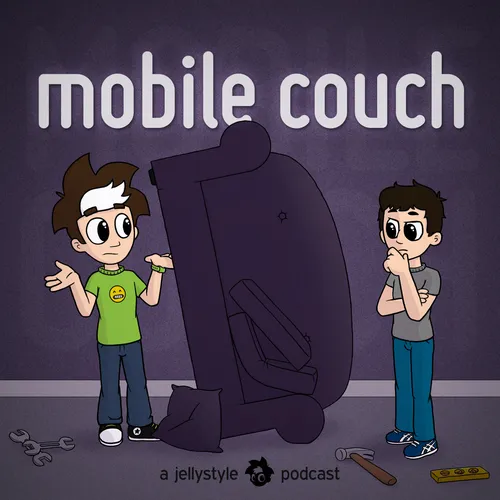
Mobile Couch
Design, development, and business; these guys do it all. Ben Trengrove and Daniel “Jelly” Farrelly are two iOS developers who work on everything from games to client projects, sharing techniques and best practices for creating stunning mobile applications.
- Update frequency
- every 14 days
- Average duration
- 58 minutes
- Episodes
- 98
- Years Active
- 2013 - 2016

38: Diversified the Man
Basil Shkara - indie developer and creator of Bee - joins Ben and Jelly to discuss succeeding as an indie developer, marketing your app, and the scary world of SEO optimisation.
Show notes:

37: Screaming Out for Testing
Ben, Jake and Jelly discuss access control, using target/selector style method calls, and avoiding retain cycles in Swift (with a recap on how to debug them with Heapshot Analysis). They then take a …

36: Vice President of Something
Jelly hasn’t had enough discussion of diversity yet, Jake discusses whether Apple should use a stick or a carrot to try to enforce accessible apps, and Ben explains how the Swift runtime works.
Mean…

35: Hashtag Digital Synergization
Jelly talks about his new open-source library (and its terrible name), which leads into a discussion about the differences between table and collection views in iOS. Jake discusses his recent work wi…

34: Tuples, Chuples, Twooples
Swift: everyone’s excited about it, but that doesn’t mean it’s without oddities, shortfalls and issues. The couch attempts to cover as much of what they’ve learned so far about Apple’s new programmin…

33: Ukelele and Claps
Russell Ivanovic joins Jake and Jelly to discuss the fall out from this year’s WWDC: the things they’re excited about, the things that are going to change the ecosystem, and most importantly, the sto…

32: More Static Analyser Warnings
Following up on the discussion about auto layout in the last episode, Jake and Jelly team up to compare it with manual frame management in a view from one of Jelly’s projects. Then come the WWDC pred…

31: God Knows I’m Not a Smart Developer
It’s a rapid-fire episode, as the couch discusses follow-up about replacing Objective-C, C#’s async/await feature, supporting iOS 6 and 7’s UI, using Auto Layout to simplify UI layout math, the benef…

30: Turtles All the Way Down
Instead of learning enough to talk about it himself, Jake probes Ash Furrow – author of Functional Reactive Programming on iOS – about functional programming, ReactiveCocoa, and the future of Objecti…

29: They Don’t Have Popcorn at WWDC
Creating an inclusive and flexible culture, whether it be through the way you speak, or simply by understanding the differences between people’s personal priorities. Follow-up about code-style leads …

28: Whitespace Wars
The couch discusses about code styles and conventions: using tabs or spaces, casing in class names, and how to name consts. Along the way, Ben, Jake and Jelly touch on whether consistency is importan…

27: You Can Sit Next to a Black Hole
Jake and Ben tell us all about their experiences using Bluetooth LE beacons as part of their most recent joint project: how beacons work, triangulating a user’s location by laying out a series of bea…

26: The Prize is No Ads
Lessons learned from the launch of Jelly’s latest app, GIFwrapped: expedited reviews, asking for reviews within the update notes, helping users, enabling and setting up iAd, as well as disabling Ads …

25: God Rest Its Soul
Marc Edwards - designer and podcast co-host - claims a spot on the couch to share how Bjango got started building Mac and iOS apps, as well as some insight on Skala and its place in the world. We als…

24: When It Goes Bad, It Goes So Bad
Feedback about asking for ratings prompts a discussion about when alert views should be used and when a different approach might be better; dealing with personally identifiable data within Australia,…

23: He Wants to Spy on Us
The benefits (and the costs) of open sourcing your code; using HockeyApp to track beta testers, why you might want to do such a thing (or not), and a discussion about the various methods of learning …

22: Together, You Are Captain Planet
Ben and Jelly travel to Kinglake, Victoria for NSCamp: a long weekend of coding and hacking for mobile devices. While they’re there, they do a special episode for the attendees, conducting lightning …

21: Of Which There Are Many and Various
The effect that NDAs have on a project, do they help an app succeed, or are they unnecessary? Ben asks for some freelancing tips, which leads to a discussion of how to quote on work and what to do to…

20: We Used to Grind Pixels Every Day
With Jelly’s need for a new Macbook Pro and the recent Apple event, now is as good a time as any to discuss the fallout, including new hardware and the consumer expectation of free software; Jake pre…

19: Say a Teacher Has Lots of iPhones
Jake’s excited about iBeacons, and so he discusses use cases, implementation and where to get actual beacons from; and we follow it up with a discussion about Core Data: what it is, what it’s useful …